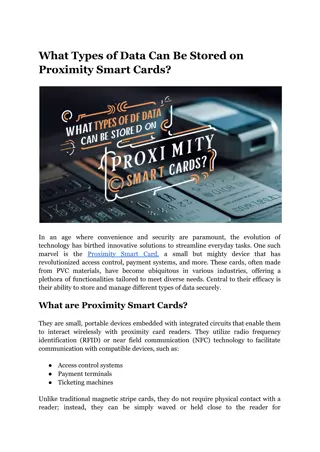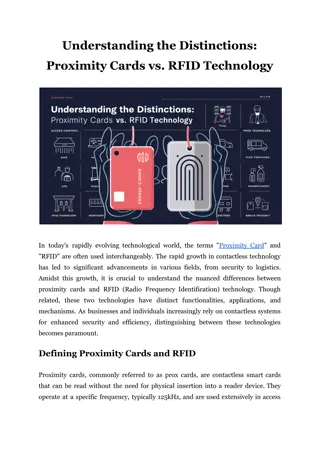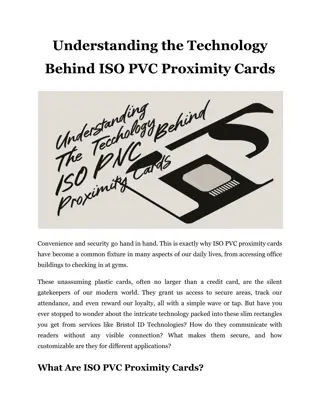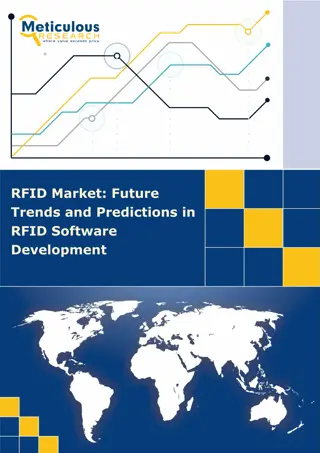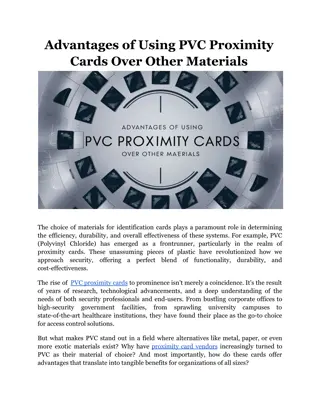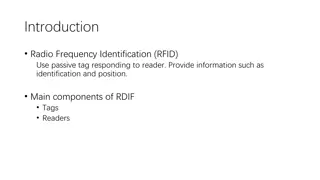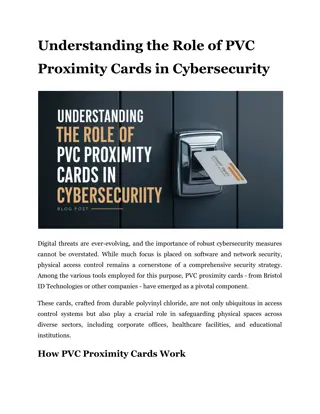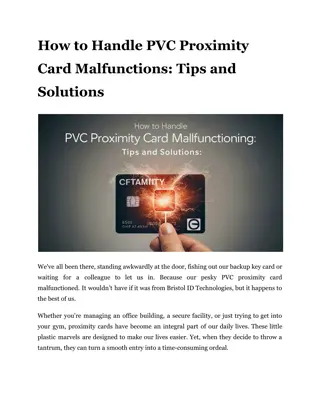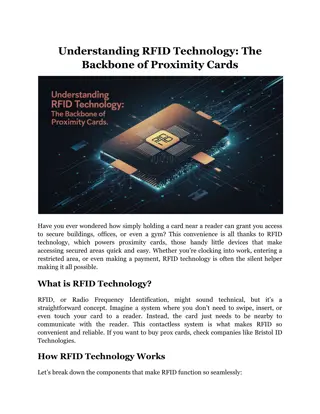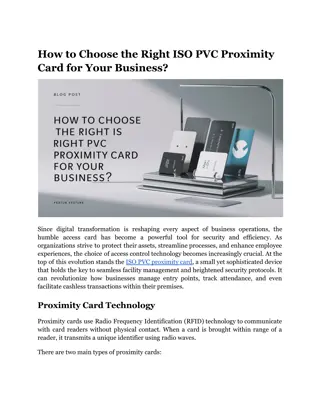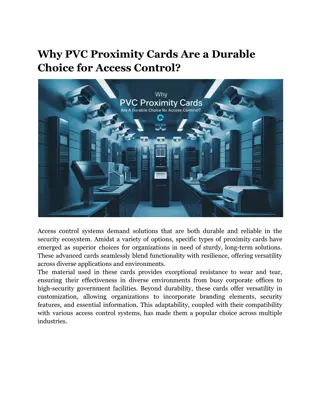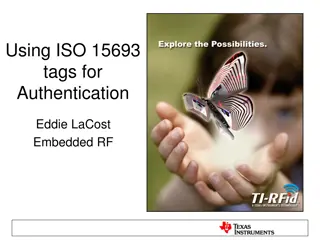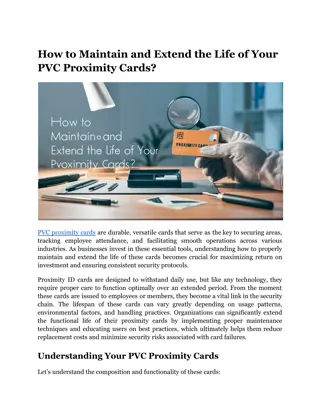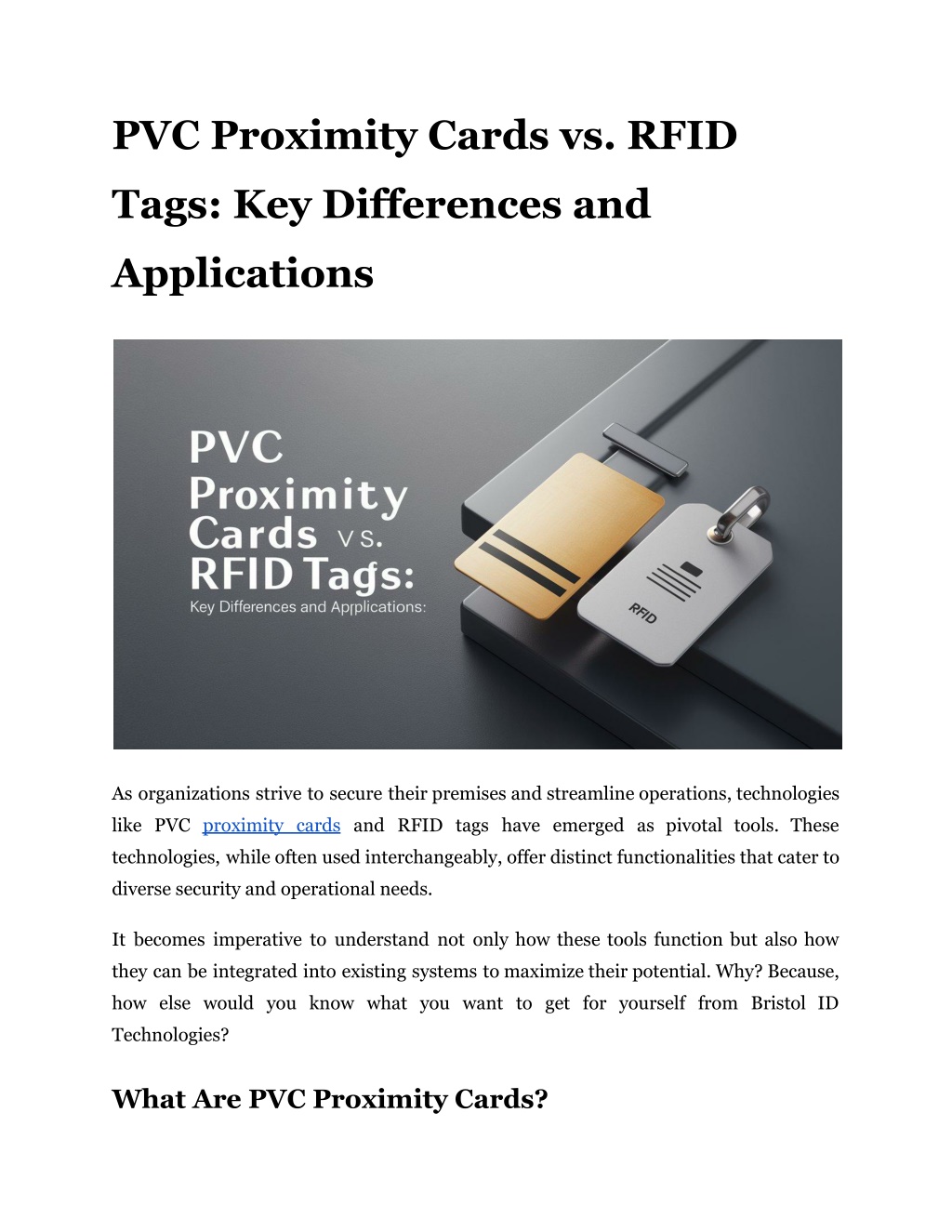
PVC Proximity Cards vs. RFID Tags_ Key Differences and Applications
Discover the differences between PVC proximity cards and RFID tags. Learn their unique applications in security systems.
Download Presentation

Please find below an Image/Link to download the presentation.
The content on the website is provided AS IS for your information and personal use only. It may not be sold, licensed, or shared on other websites without obtaining consent from the author. Download presentation by click this link. If you encounter any issues during the download, it is possible that the publisher has removed the file from their server.
E N D
Presentation Transcript
PVC Proximity Cards vs. RFID Tags: Key Differences and Applications As organizations strive to secure their premises and streamline operations, technologies like PVC proximity cards and RFID tags have emerged as pivotal tools. These technologies, while often used interchangeably, offer distinct functionalities that cater to diverse security and operational needs. It becomes imperative to understand not only how these tools function but also how they can be integrated into existing systems to maximize their potential. Why? Because, how else would you know what you want to get for yourself from Bristol ID Technologies? What Are PVC Proximity Cards?
PVC Proximity Card is a staple in access control systems. Operating at a low frequency, typically around 125 kHz, these cards are designed to be read-only, transmitting data to a reader without the capability to store additional information or be rewritten. This characteristic makes them ideal for simple, straightforward access control systems where security requirements are moderate. FYI the newer version of these cards that you might hear about is the HID Prox Card II. Key Features of PVC Proximity Cards 1. Low-Frequency Operation: Proximity cards generally operate at a low frequency, making them suitable for applications where close-range scanning is preferred. This low frequency (125 kHz) is the industry standard for HID Proximity Cards, offering reliable performance in various environments. 2. Read-Only Capability: One of the primary characteristics of PVC proximity cards is their read-only functionality. Once programmed, the data on these cards cannot be altered, which ensures consistent and secure access control without the need for complex data management systems. 3. Limited Range: Proximity card has a limited operational range, usually only a few centimeters. This close proximity requirement is often seen as a security feature, reducing the risk of unauthorized access from a distance. Read More Article: Advantages of Using PVC Proximity Cards Over Other Materials Common Applications of PVC Proximity Cards Access Control in Office Buildings: Proximity cards are widely used in office environments for secure entry and exit. Their simplicity and reliability make them a preferred choice for businesses looking to control access without the need for complex security systems. Hotel Room Keys: Many hotels use proximity cards for room access. These cards are convenient for guests and staff, allowing for easy access while maintaining security.
Residential Complexes: In residential settings, these cards are commonly used to control access to common areas such as gyms, pools, and parking garages. What Are RFID Tags? Radio Frequency Identification (RFID) tags represent a more advanced form of access control and tracking technology. Unlike proximity cards, RFID tags can operate at various frequencies, including low, high, and ultra-high, allowing them to be read from much greater distances. RFID tags can be either passive or active, with active tags containing their own power source, enabling longer range and more dynamic applications. Key Features of RFID Tags 1. Multi-Frequency Operation: RFID tags are versatile in terms of the frequencies they can operate on. Whether at low, high, or ultra-high frequencies, these tags can be customized to suit different applications, from short-range access control to long-distance tracking. 2. Read and Write Capabilities: Unlike proximity cards, RFID tags support both read and write functions. This means data on the tags can be updated or rewritten, making them ideal for dynamic environments where information needs to be frequently changed or updated. 3. Extended Range: RFID tags, particularly active ones, can be read from several meters away. This extended range opens up a wide array of possibilities, from inventory tracking in large warehouses to asset management across expansive facilities. Common Applications of RFID Tags Inventory Management: RFID tags are widely used in retail and logistics industries for real-time tracking of inventory. This capability significantly
improves supply chain efficiency, allowing companies to monitor stock levels, manage orders, and reduce losses due to theft or misplacement. Asset Tracking: In industries such as healthcare, manufacturing, and IT, RFID tags are employed to monitor the location and status of valuable assets. This enhances operational efficiency by ensuring that critical equipment is always accounted for and in the right place. Security Systems: For high-security environments, RFID tags offer advanced encryption capabilities, making them ideal for applications where data protection is paramount. This includes secure facilities, government buildings, and sensitive research labs. Data Collection: RFID technology is also used for detailed data collection in environments like healthcare and manufacturing. For instance, in hospitals, RFID tags can track patient movement, medication administration, and equipment usage, providing valuable data for improving patient care and operational efficiency. Comparative Analysis: PVC Proximity Cards vs. RFID Tags Understanding the fundamental differences between PVC proximity cards and RFID tags is crucial for making informed decisions about which technology to deploy in specific scenarios. Here s a side-by-side comparison of the two: Feature PVC Cards Proximity RFID Tags Operating Frequency Low (125 kHz) Low, High, Ultra-High Read/Write Capability Read-Only Read and Write Range Limited centimeters) (a few Extended (up to several meters)
Power Source None (Passive) Passive or Active Security Basic Advanced Encryption Cost Generally Lower Varies (higher for active tags) Typical Cases Use Access Control Inventory Management, Asset Tracking, Security Systems Read More Article: The Importance of Backup Systems in Proximity Card Access Control Choosing the Right Technology for Your Needs When deciding between PVC proximity cards and RFID tags, consider the specific requirements of your application. For instance, if you need a straightforward, cost-effective solution for access control in an office or residential complex, the HID Prox Card might be the best fit. Their simplicity, reliability, and lower cost make them an attractive option for environments where close-range access control is sufficient. On the other hand, if your application involves tracking assets over a large area, managing inventory in real-time, or requiring dynamic data management, RFID Tags are likely the better choice. The ability to operate over longer distances, update information on the fly, and incorporate advanced security features makes RFID technology ideal for more complex and demanding environments. The Future of Access Control and Tracking As technology continues to advance, the lines between different access control and tracking systems are likely to blur. We may see hybrid solutions that combine the best features of both proximity cards and RFID tags, offering greater flexibility and functionality. However, for now, understanding the strengths and limitations of each technology is key to making the right choice. Carefully consider your specific needs and the capabilities of
each technology, and select the solution that best meets your requirements. Then, order away so Bristol ID Technologies can get your cards to you in no time! Site Article: PVC Proximity Cards vs. RFID Tags: Key Differences and Applications



